Spring Boot是Pivotal团队在Spring的基础上提供的一套全新的开源框架,其目的是为了简化Spring应用的搭建和开发过程。Spring Boot去除了大量的XML配置文件,简化了复杂的依赖管理。
Spring Boot入门
简介
Spring Boot是简化Spring应用开发的一个框架、整个Spring技术栈的一个大整合(Spring全家桶时代)、J2EE开发的一站式解决方案(Spring Cloud是分布式整体解决方案)。
优点:
– 快速创建独立运行的Spring项目以及与主流框架集成
– 使用嵌入式的Servlet容器,应用无需打成WAR包
– starters自动依赖与版本控制
– 大量的自动配置,简化开发,也可修改默认值
– 无需配置XML,无代码生成,开箱即用
– 准生产环境的运行时应用监控
– 与云计算的天然集成
单体应用与微服务
– 单体应用:ALL IN ONE(所有内容都在一个应用里面)
– 微服务:每一个功能元素最终都是一个可独立替换和独立升级的软件单元
微服务是一种架构风格(服务微化),一个应用应该是一组小型服务,可以通过HTTP的方式进行互通
HelloWorld案例
工程创建及案例可以参考文章进行操作:在IDEA中创建SpringBoot项目
POM文件
父项目是Spring Boot的版本仲裁中心(他来真正管理Spring Boot应用里面的所有依赖版本),以后我们导入依赖默认是不需要写版本(没有在dependencies里面管理的依赖自然需要声明版本号)
<parent>
<groupId>org.springframework.boot</groupId>
<artifactId>spring-boot-starter-parent</artifactId>
<version>2.7.11</version>
<relativePath/> <!-- lookup parent from repository -->
</parent>
启动器 **spring-boot-starter(spring-boot场景启动器)**,spring-boot-starter-web 帮我们导入了web模块正常运行所依赖的组件。
<dependencies>
<dependency>
<groupId>org.springframework.boot</groupId>
<artifactId>spring-boot-starter-web</artifactId>
</dependency>
<dependency>
<groupId>org.springframework.boot</groupId>
<artifactId>spring-boot-starter-test</artifactId>
<scope>test</scope>
</dependency>
</dependencies>
Spring Boot将所有的功能场景都抽取出来,做成一个个的starters(启动器),只需要在项目里面引入这些starter相关场景的所有依赖都会导入进来。要用什么功能就导入什么场景的启动器。
主程序类
// 自动生成的
@SpringBootApplication
public class SpringBootDemo0Application {
public static void main(String[] args) {
SpringApplication.run(SpringBootDemo0Application.class, args);
}
}
@SpringBootApplication: Spring Boot应用标注在某个类上说明这个类是SpringBoot的主配置类,SpringBoot 就应该运行这个类的main方法来启动SpringBoot应用。
Spring Boot配置
配置文件
SpringBoot使用一个全局的配置文件,配置文件名固定:**application.properties** 或者 **application.yml**。配置文件放在 src/main/resources目录 或者 类路径/config 下。作用是修改SpringBoot自动配置的默认值。
YAML
YAML(YAML Ain’t Markup Language),**.yml**为结尾,以数据为中心,比json、xml等更适合做配置文件。
YAML配置例子
server:
port: 8081
等价于XML配置:
<server>
<port>8081</port>
</server>
【语法】key: value(注意冒号后面有个空格)
以空格的缩进来控制层级关系,只要是左对齐的一列数据,都是同一个层级
【值写法】
(1)字面量:普通的值(数字,字符串,布尔)
- k: v,字面量直接写
- 字符串默认不用加上单引号或者双引号
- “”(双引号),name: “zhangsan \n lisi” 会输出 zhangsan 换行 lisi
- ”(单引号),name: ‘zhangsan \n lisi’ 会输出 zhangsan \n lisi
(2)对象、Map
- k: v,在下一行来写对象的属性和值
friends:
lastName: zhangsan
age: 20
或者:
friends: {lastName:zhangsan,age:18}
(3)数组(List、Set)
- 用- 值表示数组中的一个元素
pets:
‐ cat
‐ dog
‐ pig
pets: [cat,dog,pig]
配置文件值注入 🔥
@ConfigurationProperties
1)导入配置文件处理器
<!‐‐导入配置文件处理器,配置文件进行绑定就会有提示‐‐>
<dependency>
<groupId>org.springframework.boot</groupId>
<artifactId>spring-boot-configuration-processor</artifactId>
<optional>true</optional>
</dependency>
2)javaBean对象@ConfigurationProperties(prefix = "person") 会将配置文件和类进行绑定:
/**
* 将配置文件中配置的每一个属性的值,映射到这个组件中
* @ConfigurationProperties:告诉SpringBoot将本类中的所有属性和配置文件中相关的配置进行绑定;
* prefix = "person":配置文件中哪个下面的所有属性进行一一映射
* 只有这个组件是容器中的组件,才能容器提供的@ConfigurationProperties功能;
*/
@Component
@ConfigurationProperties(prefix = "person")
public class Person {
private String lastName;
private Integer age;
private Boolean boss;
private Date birth;
private Map<String, Object> maps;
private List<Object> lists;
private Dog dog;
....
}
3)配置文件 application.yml
person:
lastName: haha
age: 18
boss: false
birth: 2022/01/01
maps: {k1: v1,k2: v2}
lists:
- lisi
- wangwu
dog:
name: 芒果
age: 1
或者配置文件application.properties
#解决乱码问题
spring.message.encoding=UTF-8
#person
person.last-name=haha
person.age=20
person.birth=2022/01/02
person.boss=true
person.maps.k1=v1
person.maps.k2=v2
person.lists=a,b,c
person.dog.name=丸子
person.dog.age=5
乱码问题还需要配置:

4)单元测试,先将内容注入(@Autowired)然后使用
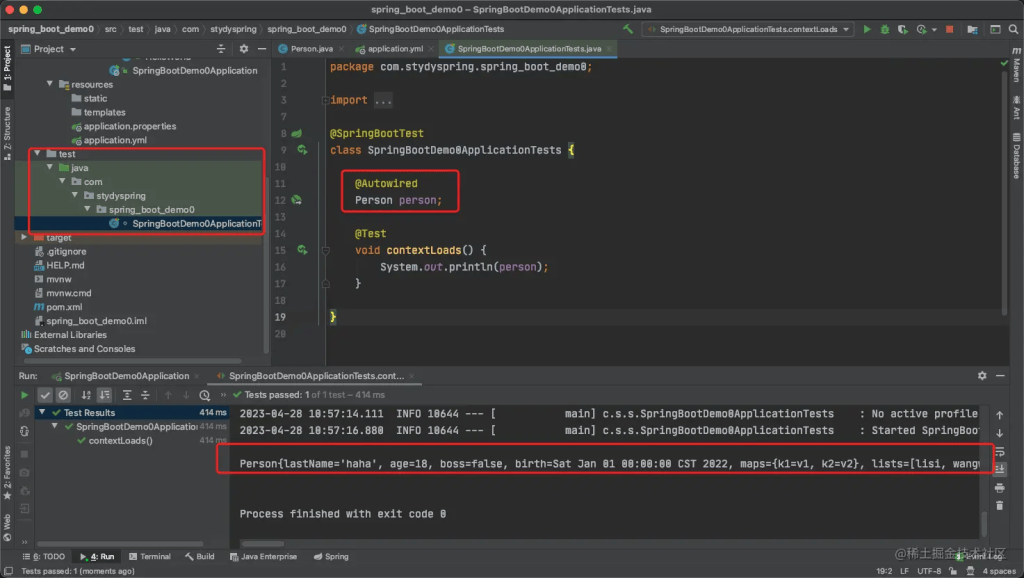
与@Value的区别
@ConfigurationProperties 与 @Value 的区别:
- @ConfigurationProperties 是批量注入配置文件中的属性,@Value 是一个个指定
- @ConfigurationProperties 支持松散绑定(松散语法) 、不支持SpEL(表达式如#{2*4})、支持JSR303数据校验 、支持复杂类型封装(如map)
- @Value 不支持松散绑定(松散语法) 、支持SpEL、不支持JSR303数据校验 、不支持复杂类型封装
@Component
// @ConfigurationProperties(prefix = "person")
public class Person {
@Value("${person.last-name}")
private String lastName;
@Value("#{2*4}")
private Integer age;
@Value("true")
private Boolean boss;
@Value("${person.birth}")
private Date birth;
...
松散绑定:
– person.firstName:使用标准方式
– person.first-name:大写用-
– person.first_name:大写用_
– PERSON_FIRST_NAME:推荐系统属性使用这种写法
使用规则:
- 如果说,我们只是在某个业务逻辑中需要获取一下配置文件中的某项值,使用@Value
@Value("${febase.api.host}")
private String febaseHost;
- 如果说,我们专门编写了一个javaBean来和配置文件进行映射,我们就直接使用@ConfigurationProperties
读取外部配置文件
@PropertySource:加载指定的配置文件
@PropertySource("classpath:person.properties")
@Component
@ConfigurationProperties(prefix = "person")
public class Person {
private String lastName;
private Integer age;
private Boolean boss;
...
}
@ImportResource:导入Spring的配置文件,让配置文件里面的内容生效--标注在一个配置类上
如下我们自己编写的配置文件:
<?xml version="1.0" encoding="UTF-8"?>
<beans xmlns="http://www.springframework.org/schema/beans"
xmlns:xsi="http://www.w3.org/2001/XMLSchema-instance"
xsi:schemaLocation="http://www.springframework.org/schema/beans http://www.springframework.org/schema/beans/spring-beans.xsd">
<bean id="helloService" class="com.stydyspring.spring_boot_demo0.service.HelloService"></bean>
</beans>
我们可以标注在主配置类上:
@SpringBootApplication
// 导入Spring的配置文件让其生效
@ImportResource(locations = {"classpath:beans.xml"})
public class SpringBootDemo0Application {
public static void main(String[] args) {
SpringApplication.run(SpringBootDemo0Application.class, args);
}
}
测试:
@SpringBootTest
class SpringBootDemo0ApplicationTests {
@Autowired
ApplicationContext ioc;
@Test
public void testHelloService(){
boolean containsBean = ioc.containsBean("helloService");
System.out.println(containsBean);
// 上一步没加@ImportResource之前返回false
// 添加@ImportResource之后返回true
}
}
SpringBoot推荐给容器中添加组件的方式,推荐使用全注解的方式 @Configuration
/**
* @Configuration:指明当前类是一个配置类,就是来替代之前的Spring配置文件
*
* 在配置文件中用<bean><bean/>标签添加组件。在配置类中使用@Bean注解
*/
@Configuration
public class MyAppConfig {
// 将方法的返回值添加到容器中;容器中这个组件默认的id就是方法名
@Bean
public HelloService helloService(){
System.out.println("配置类@Bean给容器中添加组件了");
return new HelloService();
}
}
配置文件占位符
随机数
${random.value}、${random.int}、${random.long}、${random.uuid}
${random.int(10)}、${random.int[1024,65536]}
占位符获取之前配置的值,如果没有可以是用:指定默认值
#person
person.last-name=haha${random.uuid}
person.age=${random.int}
person.birth=2222/02/02
person.boss=false
person.maps.k1=v11111
person.maps.k2=v22222
person.lists=a,b,c,d,e,f
person.dog.name=${person.hello:hello}_dog
person.dog.age=1
Profile 🔥
Profile是Spring对不同环境提供不同配置功能的支持,可以通过激活、指定参数等方式快速切换环境。
多profile文件形式格式如:**application-{profile}.properties/yml**,如 application-dev.properties、application-prod.properties
默认使用application.properties的配置
激活方式:
- 命令行
--spring.profiles.active=dev- java -jar spring-boot-02-config-0.0.1-SNAPSHOT.jar –spring.profiles.active=dev;
- 配置文件
spring.profiles.active=dev - jvm参数
–Dspring.profiles.active=dev
yml支持多文档块方式:
server:
port: 8081
spring:
profiles:
active: prod
‐‐‐
server:
port: 8083
spring:
profiles: dev
‐‐‐
server:
port: 8084
spring:
profiles: prod #指定属于哪个环境
配置文件加载位置
spring boot 启动会扫描以下位置的application.properties或者application.yml文件作为Spring boot的默认配置文件
- file:./config/
- file:./
- classpath:/config/
- classpath:/
以上是按照优先级从高到低的顺序,所有位置的文件都会被加载,高优先级配置内容会覆盖低优先级配置内容。
可以通过配置spring.config.location来改变默认配置。项目打包好以后,可以使用命令行参数的形式,启动项目的时候来指定配置文件的新位置;指定配置文件和默认加载的这些配置文件共同起作用形成互补配置:
java -jar spring-boot-02-config-02-0.0.1-SNAPSHOT.jar –spring.config.location=G:/application.properties
外部配置加载顺序
Spring Boot支持多种外部配置方式,优先级从高到低。高优先级的配置覆盖低优先级的配置,所有的配置会形成互补配置:
- 命令行参数
- 所有的配置都可以在命令行上进行指定:java -jar spring-boot-02-config-02-0.0.1-SNAPSHOT.jar –server.port=8087 –server.context-path=/abc
- 多个配置用空格分开;
--配置项=值
- 来自java:comp/env的JNDI属性
- Java系统属性(System.getProperties())
- 操作系统环境变量
- RandomValuePropertySource配置的random.*属性值
由jar包外向jar包内进行寻找。优先加载带profile:
- jar包外部的application-{profile}.properties或application.yml(带spring.profile)配置文件
- jar包内部的application-{profile}.properties或application.yml(带spring.profile)配置文件
再来加载不带profile:
- jar包外部的application.properties或application.yml(不带spring.profile)配置文件
- jar包内部的application.properties或application.yml(不带spring.profile)配置文件
- @Configuration注解类上的@PropertySource
- 通过SpringApplication.setDefaultProperties指定的默认属性
自动配置原理
配置文件可以配置的属性:docs.spring.io/spring-boot…
自动配置原理:
1)Spring Boot启动时加载主配置类(带有@SpringBootApplication),其里面开启了自动配置功能@EnableAutoConfiguration
2)@EnableAutoConfiguration利用@Import(AutoConfigurationImportSelector.class)给容器导入一些组件。导入的组件是通过List configurations = getCandidateConfigurations(annotationMetadata, attributes);获取到的。里面通过SpringFactoriesLoader.loadFactoryNames 扫描所有jar包类路径下”META-INF/spring.factories”,把扫描到的这些文件的内容包装成properties对象,从properties中获取到EnableAutoConfiguration.class类(类名)对应的值,然后把他们添加在容器中。其实就是将类路径下 META-INF/spring.factories 里面配置的所有EnableAutoConfiguration的值加入到了容器中。每一个这样的 xxxAutoConfiguration 类都是容器中的一个组件,都加入到容器中;用他们来做自动配置;
3)每一个自动配置类进行自动配置功能
4)以HttpEncodingAutoConfiguration配置类进行分析:
// 表示这是一个配置类,以前编写的配置文件一样,也可以给容器中添加组件
@AutoConfiguration
// 启动指定类的ConfigurationProperties功能,将配置文件中对应的值和xxxProperties绑定起来,并把xxxProperties加入到ioc容器中
@EnableConfigurationProperties(ServerProperties.class)
// Spring底层@Conditional注解(Spring注解版),根据不同的条件,如果满足指定的条件,整个配置类里面的配置就会生效;
@ConditionalOnWebApplication(type = ConditionalOnWebApplication.Type.SERVLET)
// 判断当前项目有没有这个类CharacterEncodingFilter-SpringMVC中进行乱码解决的过滤器
@ConditionalOnClass(CharacterEncodingFilter.class)
// 判断配置文件中是否存在某个配置 spring.servlet.encoding.enabled;如果不存在,判断也是成立的
// 即使我们配置文件中不配置spring.servlet.encoding.enabled=true,也是默认生效的;
@ConditionalOnProperty(prefix = "server.servlet.encoding", value = "enabled", matchIfMissing = true)
public class HttpEncodingAutoConfiguration {
// 他已经和SpringBoot的配置文件映射了
private final Encoding properties;
// 只有一个有参构造器的情况下,参数的值就会从容器中拿
public HttpEncodingAutoConfiguration(ServerProperties properties) {
this.properties = properties.getServlet().getEncoding();
}
@Bean // 给容器中添加一个组件,这个组件的某些值需要从properties中获取
@ConditionalOnMissingBean // 判断容器没有这个组件,就给配置一个
public CharacterEncodingFilter characterEncodingFilter() {
CharacterEncodingFilter filter = new OrderedCharacterEncodingFilter();
filter.setEncoding(this.properties.getCharset().name());
filter.setForceRequestEncoding(this.properties.shouldForce(Encoding.Type.REQUEST));
filter.setForceResponseEncoding(this.properties.shouldForce(Encoding.Type.RESPONSE));
return filter;
}
...
}
根据当前不同的条件判断,决定这个配置类是否生效
一但这个配置类生效,这个配置类就会给容器中添加各种组件,这些组件的属性是从对应的properties类中获取的,这些类里面的每一个属性又是和配置文件绑定的
5)、所有在配置文件中能配置的属性都是在xxxxProperties类中封装着,配置文件能配置什么就可以参照某个功能对应的这个属性类
使用精髓:
1)、SpringBoot启动会加载大量的自动配置类 ;
2)、我们看我们需要的功能有没有SpringBoot默认写好的自动配置类;
3)、我们再来看这个自动配置类中到底配置了哪些组件(只要我们要用的组件有,我们就不需要再来配置了)
4)、给容器中自动配置类添加组件的时候,会从properties类中获取某些属性。我们就可以在配置文件中指定这些属性的值;
xxxxAutoConfigurartion:自动配置类; 给容器中添加组件
xxxxProperties:封装配置文件中相关属性
@Conditional注解
作用:必须是@Conditional指定的条件成立,才给容器中添加组件,配置配里面的所有内容才生效
也就是说,自动配置类必须在一定的条件下才能生效
| @Conditional扩展注解 | 作用(判断是否满足当前指定条件) |
|---|---|
| @ConditionalOnJava | 系统的java版本是否符合要求 |
| @ConditionalOnBean | 容器中存在指定Bean |
| @ConditionalOnMissingBean | 容器中不存在指定Bean |
| @ConditionalOnExpression | 满足SpEL表达式指定 |
| @ConditionalOnClass | 系统中有指定的类 |
| @ConditionalOnMissingClass | 系统中没有指定的类 |
| @ConditionalOnSingleCandidate | 容器中只有一个指定的Bean,或者这个Bean是首选Bean |
| @ConditionalOnProperty | 系统中指定的属性是否有指定的值 |
| @ConditionalOnResource | 类路径下是否存在指定资源文件 |
| @ConditionalOnWebApplication | 当前是web环境 |
| @ConditionalOnNotWebApplication | 当前不是web环境 |
| @ConditionalOnJndi | JNDI存在指定项 |
想要查看生效的自动配置类,可以在配置文件中配置debug=true,positive为启动的,negative没启用的
Spring Boot与日志
日志框架
市场上存在非常多的日志框架:JUL(java.util.logging),JCL(Apache Commons Logging),Log4j,Log4j2,Logback、SLF4j、jboss-logging等。 Spring Boot在框架内容部使用JCL,spring-boot-starter-logging采用了 slf4j+logback的形式,Spring Boot也能自动适配(jul、log4j2、logback) 并简化配置
SpringBoot底层是Spring框架,Spring框架默认是用JCL。SpringBoot选用SLF4j(日志抽象层)和logback(日志实现)
SLF4j
开发时日志记录方法的调用,不应该来直接调用日志的实现类,而是调用日志抽象层里面的方法:
import org.slf4j.Logger;
import org.slf4j.LoggerFactory;
public class HelloWorld {
public static void main(String[] args) {
Logger logger = LoggerFactory.getLogger(HelloWorld.class);
logger.info("Hello World");
}
}
每一个日志的实现框架都有自己的配置文件。使用slf4j以后,配置文件还是做成日志实现框架自己本身的配置文件。
如何让系统中所有的日志都统一到slf4j:
- 将系统中其他日志框架先排除出去
- 用中间包来替换原有的日志框架
- 我们导入slf4j其他的实现
SpringBoot日志关系
添加依赖:
<dependency>
<groupId>org.springframework.boot</groupId>
<artifactId>spring-boot-starter-logging</artifactId>
</dependency>
SpringBoot能自动适配所有的日志,而且底层使用slf4j+logback的方式记录日志,引入其他框架的时候,只需要把这个框架依赖的日志框架排除掉即可
<dependency>
<groupId>org.springframework</groupId>
<artifactId>spring‐core</artifactId>
<exclusions>
<exclusion>
<groupId>commons‐logging</groupId>
<artifactId>commons‐logging</artifactId>
</exclusion>
</exclusions>
</dependency>
默认日志配置
日志级别由低到高:trace<debug<info<warn<error
SpringBoot默认给我们使用的是info级别的(日志就只会在这个级别及以后的高级别生效),没有指定级别的就用SpringBoot默认规定的级别。
日志输出格式:
- %d –表示日期时间
- %thread –表示线程名
- %‐5level –级别从左显示5个字符宽度
- %logger{50} –表示logger名字最长50个字符,否则按照句点分割
- %msg –日志消息
- %n –是换行符
public class Hello {
// 记录器
Logger logger = LoggerFactory.getLogger(getClass());
@RequestMapping("/world")
public String hello() {
logger.trace("trace日志");
logger.debug("debug日志");
// 默认
logger.info("info日志");
logger.warn("warn日志");
logger.error("error日志");
return "Hello World~";
}
}
默认是info,所以只会输出:
2023-05-23 11:44:27.419 INFO 98527 --- [nio-8080-exec-2] c.s.spring_boot_demo3.controller.Hello : info日志
2023-05-23 11:44:27.419 WARN 98527 --- [nio-8080-exec-2] c.s.spring_boot_demo3.controller.Hello : warn日志
2023-05-23 11:44:27.419 ERROR 98527 --- [nio-8080-exec-2] c.s.spring_boot_demo3.controller.Hello : error日志
修改默认级别:
logging.level.com.study=trace
2023-05-23 11:50:00.774 TRACE 98971 --- [nio-8080-exec-1] c.s.spring_boot_demo3.controller.Hello : trace日志
2023-05-23 11:50:00.774 DEBUG 98971 --- [nio-8080-exec-1] c.s.spring_boot_demo3.controller.Hello : debug日志
2023-05-23 11:50:00.774 INFO 98971 --- [nio-8080-exec-1] c.s.spring_boot_demo3.controller.Hello : info日志
2023-05-23 11:50:00.774 WARN 98971 --- [nio-8080-exec-1] c.s.spring_boot_demo3.controller.Hello : warn日志
2023-05-23 11:50:00.774 ERROR 98971 --- [nio-8080-exec-1] c.s.spring_boot_demo3.controller.Hello : error日志
日志配置:
| logging.file.name(建议) | logging.file.path | 例子 | 备注 |
|---|---|---|---|
| 空 | 空 | 只在控制台输出 | |
| 指定文件名 | 空 | my.log | 输出日志到my.log文件 |
| 空 | 指定目录 | /var/log | 输出到指定目录的 spring.log 文件中 |
# 日志
# logging.file.name=my.log
# 配置日志路径,默认在此目录下生成一个名为:spring.log的日志文件
logging.file.path=/test/log
# 在控制台输出的日志的格式
logging.pattern.console=%d{yyyy‐MM‐dd}[%thread]%‐5level%logger{50}‐%msg%n
# 指定文件中日志输出的格式
logging.pattern.file=%d{yyyy‐MM‐dd}===[%thread]===%‐5level===%logger{50}====%msg%n
指定日志配置
给类路径下放上每个日志框架自己的配置文件即可,SpringBoot就不使用他默认配置的了
| 日志系统 | 自定义配置文件 |
|---|---|
| Logback | logback-spring.xml , logback-spring.groovy, logback.xml or logback.groovy |
| Log4j2 | log4j2-spring.xml or log4j2.xml |
| JDK (Java Util Logging) | logging.properties |
logback.xml:直接就被日志框架识别了;
logback-spring.xml:日志框架就不直接加载日志的配置项,由SpringBoot解析日志配置,可以使用SpringBoot的高级Profile功能(激活对应环境下生效)
<springProfilename="staging">
<!‐‐ configuration to be enabled when the "staging" profile is active ‐‐>
可以指定某段配置只在某个环境下生效
</springProfile>
<appendername="stdout" class="ch.qos.logback.core.ConsoleAppender">
<layout class="ch.qos.logback.classic.PatternLayout">
<springProfile name="dev">
<pattern>%d{yyyy‐MM‐dd HH:mm:ss.SSS} ‐‐‐‐> [%thread] ‐‐‐> %‐5level
%logger{50} ‐ %msg%n</pattern>
</springProfile>
<springProfile name="!dev">
<pattern>%d{yyyy‐MM‐dd HH:mm:ss.SSS} ==== [%thread] ==== %‐5level
%logger{50} ‐ %msg%n</pattern>
</springProfile>
</layout>
</appender>
Spring Boot与Web开发
静态资源映射规则
1)所有 /webjars/** ,都去 classpath:/META-INF/resources/webjars/ 找资源
webjars:是以jar包的方式引入静态资源(网址:www.webjars.org/)

引入后访问:http://localhost:8080/webjars/jquery/3.3.1/src/jquery.js,就可以找到资源:
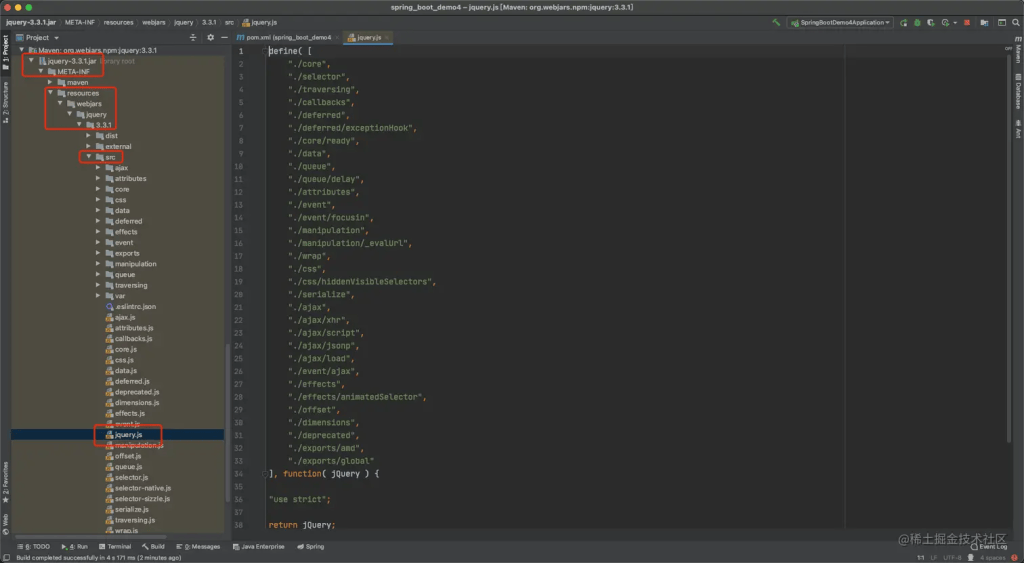
2) /** 访问当前项目的任何资源,都去「静态资源的文件夹」找映射
- “classpath:/META‐INF/resources/”
- “classpath:/resources/”
- “classpath:/static/”
- “classpath:/public/”
- “/”:当前项目的根路径
如,localhost:8080/abc,会去静态资源文件夹里面找abc
3)首页映射,静态资源文件夹下的所有index.html页面,被”/**”映射
localhost:8080/ ,会找index页面
4)所有的 **/favicon.ico 都是在静态资源文件下找
Thymeleaf模板引擎
thymeleaf使用
默认规则:只要我们把HTML页面放在classpath:/templates/,thymeleaf就能自动渲染
// 源码
@ConfigurationProperties(prefix="spring.thymeleaf")
public class ThymeleafProperties{
private static final Charset DEFAULT_ENCODING = Charset.forName("UTF‐8");
private static final MimeType DEFAULT_CONTENT_TYPE = MimeType.valueOf("text/html");
public static final String DEFAULT_PREFIX = "classpath:/templates/";
public static final String DEFAULT_SUFFIX = ".html";
第一步)添加依赖
<dependency>
<groupId>org.springframework.boot</groupId>
<artifactId>spring-boot-starter-thymeleaf</artifactId>
</dependency>
第二步)属性配置
# 将缓存关闭
spring.thymeleaf.cache=false
第三步)创建thymeleaf模板文件
创建success.html,放入classpath:/templates/文件夹下
<!DOCTYPE html>
<!-- 导入thymeleaf的名称空间 -->
<html lang="en" xmlns:th="http://www.thymeleaf.org">
<head>
<meta charset="UTF-8">
<title>Title</title>
</head>
<body>
<h2>成功页面!</h2>
<!-- th:text将div里面的文本内容设置为name代表的数据 -->
<div th:text="${name}"></div>
</body>
</html>
第四步)编写控制器
// 这里需要使用@Controller,而不是@RestController
@Controller
@RequestMapping("/api")
public class Hello {
@ResponseBody
@RequestMapping("/hello")
public String hello() {
return "hello";
}
@RequestMapping("/success")
public String success(Model model) {
// classpath:/templates/success.html
model.addAttribute("name","alice");
return "success";
}
}
第五步)访问页面
访问http://localhost:8080/api/success,可以看到html页面内容
thymeleaf语法规则
1)th:text:改变当前元素里面的文本内容(th:任意html属性:来替换原生属性的值)

2)表达式
【 Simpleexpressions:(表达式语法) 】
1、Variable Expressions: ${...}:获取变量值(OGNL)
1)、获取对象的属性、调用方法
2)、使用内置的基本对象:
#ctx : the context object.
#vars: the context variables.
#locale : the context locale.
#request : (only in Web Contexts) the HttpServletRequest object.
#response : (only in Web Contexts) the HttpServletResponse object.
#session : (only in Web Contexts) the HttpSession object.
#servletContext : (only in Web Contexts) the ServletContext object.
3)、内置的一些工具对象:
#execInfo : information about the template being processed.
#messages : methods for obtaining externalized messages inside variables expressions, in the same way as they would be obtained using #{...} syntax.
#uris : methods for escaping parts of URLs/URIs
#conversions : methods for executing the configured conversion service (if any).
#dates : methods for java.util.Date objects: formatting, component extraction, etc.
#calendars : analogous to #dates , but for java.util.Calendar objects.
#numbers : methods for formatting numeric objects.
#strings : methods for String objects: contains, startsWith, prepending/appending, etc.
#objects : methods for objects in general.
#bools : methods for boolean evaluation.
#arrays : methods for arrays.
#lists : methods for lists.
#sets : methods for sets.
#maps : methods for maps.
#aggregates : methods for creating aggregates on arrays or collections.
#ids : methods for dealing with id attributes that might be repeated (for example, as aresult of an iteration).
2、Selection Variable Expressions: *{...}:选择表达式。和${}在功能上是一样(补充:配合th:object="${session.user})
例子:
<div th:object="${session.user}">
<p>Name: <span th:text="*{firstName}">Sebastian</span>.</p>
<p>Surname: <span th:text="*{lastName}">Pepper</span>.</p>
<p>Nationality: <span th:text="*{nationality}">Saturn</span>.</p>
</div>
3、Message Expressions: #{...}:获取国际化内容
4、Link URL Expressions: @{...}:定义URL;
例子:@{/order/process(execId=${execId},execType='FAST')}
5、Fragment Expressions: ~{...}:片段引用表达式
例子:<div th:insert="~{commons :: main}">...</div>
【 Literals(字面量) 】
Text literals: 'one text' , 'Another one!' ,...
Number literals: 0 , 34 , 3.0 , 12.3 ,...
Boolean literals: true , false
Null literal: null
Literal tokens: one , sometext , main ,...
【Text operations:(文本操作)】
String concatenation: +
Literal substitutions: |The name is ${name}|
【Arithmetic operations:(数学运算)】
Binary operators: + , ‐ , * , / , %
Minus sign (unary operator): ‐
【Booleanoperations:(布尔运算)】
Binary operators: and , or
Boolean negation (unary operator): ! , not
【Comparisonsandequality:(比较运算)】
Comparators: > , < , >= , <= ( gt , lt , ge , le )
Equality operators: == , != ( eq , ne )
【Conditionaloperators:条件运算(三元运算符)】
If‐then: (if) ? (then)
If‐then‐else: (if) ? (then) : (else)
Default: (value) ?: (defaultvalue)
【Specialtokens:(特殊操作) 】
No‐Operation: _ 代表空操作,如在三元运算符的冒号后面使用
SpringMVC自动配置
SpringMVC自动配置
Spring Boot 自动配置好了SpringMVC。以下是SpringBoot对SpringMVC的默认配置(WebMvcAutoConfiguration):
- Inclusion of
ContentNegotiatingViewResolverandBeanNameViewResolverbeans- 自动配置了ViewResolver(视图解析器:根据方法的返回值得到视图对象(View),视图对象决定如何渲染(转发或重定向))
- ContentNegotiatingViewResolver:组合所有的视图解析器的
- 如果需要定制视图解析器:我们可以自己给容器中添加一个视图解析器,ContentNegotiatingViewResolver会自动的将其组合进来;
- Support for serving static resources, including support for WebJars
- 静态资源文件夹路径、webjars
- Static
index.htmlsupport- 静态首页访问
- Custom Favicon support
- favicon.ico
- 自动注册了
Converter,GenericConverter,Formatterbeans.- Converter:转换器,public String hello(User user):类型转换使用Converter
- Formatter:格式化器,2017.12.17===Date;
- 自己添加的格式化器转换器,我们只需要放在容器中即可(使用@Bean)
- Support for
HttpMessageConverters- HttpMessageConverter:SpringMVC用来转换Http请求和响应的;User—Json;
- HttpMessageConverters是从容器中确定,获取所有的HttpMessageConverter;
- 自己给容器中添加HttpMessageConverter,只需要将自己的组件注册容器中(
**@Bean 或 @Component**)
- Automatic registration of
MessageCodesResolver:定义错误代码生成规则 - Automatic use of a
ConfigurableWebBindingInitializerbean- 初始化web数据绑定器的,WebDataBinder。他的作用是把请求数据转换为JavaBean
- 我们可以配置一个ConfigurableWebBindingInitializer来替换默认的;(添加到容器)
扩展SpringMVC
扩展方式:编写一个配置类(@Configuration),是WebMvcConfigurerAdapter类型,不能标注@EnableWebMvc。
既保留了所有的自动配置,也能用我们扩展的配置(SpringMVC的自动配置和我们的扩展配置都会起作用)
// 使用WebMvcConfigurerAdapter可以来扩展SpringMVC的功能
@Configuration
public class MyMvcConfig extends WebMvcConfigurerAdapter {
// 添加视图映射
@Override
public void addViewControllers(ViewControllerRegistry registry) {
// super.addViewControllers(registry);
// 浏览器发送 /other 请求来到 success
registry.addViewController("/other").setViewName("success");
}
}
浏览器访问 http://localhost:8080/other , 可以看到成功映射到了success页面
全面接管SpringMVC
@EnableWebMvc(不推荐使用)
SpringBoot对SpringMVC的自动配置不需要了,所有都是我们自己配置。所有的SpringMVC的自动配置都失效了。我们需要在配置类中添加@EnableWebMvc即可
// 使用WebMvcConfigurerAdapter可以来扩展SpringMVC的功能
@Configuration
// 全面接管SpringMVC
@EnableWebMvc
public class MyMvcConfig extends WebMvcConfigurerAdapter {
// 添加视图映射
@Override
public void addViewControllers(ViewControllerRegistry registry) {
// super.addViewControllers(registry);
// 浏览器发送 /other 请求来到 success
registry.addViewController("/other").setViewName("success");
}
}
接管前通过http://localhost:8080/static.html可以访问静态页面,全面接管后静态页面的规则就失效了,我们就无法直接访问了
修改SpringBoot的默认配置
模式:
1)、SpringBoot在自动配置很多组件的时候,先看容器中有没有用户自己配置的 **(@Bean、@Component)**。如果有就用用户配置的,如果没有才自动配置。如果有些组件可以有多个(如ViewResolver),则将用户配置的和自己默认的组合起来;
2)、在SpringBoot中会有非常多的xxxConfigurer帮助我们进行扩展配置
3)、在SpringBoot中会有很多的xxxCustomizer帮助我们进行定制配置
CRUD案例

1)默认访问首页
方法1:在controller中添加访问路径的匹配规则
@RequestMapping({"/", "/index.html"})
public String index() {
return "index";
}
方法2:在配置类中注册组件到容器
// 使用WebMvcConfigurerAdapter可以来扩展SpringMVC的功能
@Configuration
public class MyMvcConfig extends WebMvcConfigurerAdapter {
// 添加视图映射
@Override
public void addViewControllers(ViewControllerRegistry registry) {
registry.addViewController("/other").setViewName("success");
}
// 所有的WebMvcConfigurerAdapter组件都会一起起作用
@Bean //将组件注册在容器
public WebMvcConfigurerAdapter webMvcConfigurerAdapter(){
WebMvcConfigurerAdapter adapter = new WebMvcConfigurerAdapter() {
@Override
public void addViewControllers(ViewControllerRegistry registry) {
registry.addViewController("/").setViewName("login");
registry.addViewController("/index.html").setViewName("login");
}
};
return adapter;
}
}
2)国际化
第一步:编写国际化配置文件,抽取页面需要显示的国际化消息
第二步:SpringBoot自动配置好了管理国际化资源文件的组件
我们的配置文件可以直接放在类路径下叫messages.properties,或者在application.properties里配置路径
# 国际化配置的路径
spring.messages.basename=i18n.login
第三步:使用#{}可以在页面上获取国际化的值
<!DOCTYPE html>
<html lang="en" xmlns:th="http://www.thymeleaf.org">
<head>
<meta http-equiv="Content-Type" content="text/html; charset=UTF-8">
<meta name="viewport" content="width=device-width, initial-scale=1, shrink-to-fit=no">
<meta name="description" content="">
<meta name="author" content="">
<title>Signin Template for Bootstrap</title>
<!-- Bootstrap core CSS -->
<link href="asserts/css/bootstrap.min.css" th:href="@{/webjars/bootstrap/3.3.5/css/bootstrap.css}" rel="stylesheet">
<!-- Custom styles for this template -->
<link href="asserts/css/signin.css" th:href="@{/asserts/css/signin.css}" rel="stylesheet">
</head>
<body class="text-center">
<form class="form-signin" action="dashboard.html" th:action="@{/user/login}" method="post">
<img class="mb-4" th:src="@{/asserts/img/bootstrap-solid.svg}" src="asserts/img/bootstrap-solid.svg" width="72" height="72">
<h1 class="h3 mb-3 font-weight-normal" th:text="#{login.tip}">Please sign in</h1>
<!--判断-->
<p style="color: red" th:text="${msg}" th:if="${not #strings.isEmpty(msg)}"></p>
<label class="sr-only" th:text="#{login.username}">Username</label>
<input type="text" name="username" class="form-control" placeholder="Username" th:placeholder="#{login.username}" required="" autofocus="">
<label class="sr-only" th:text="#{login.password}">Password</label>
<input type="password" name="password" class="form-control" placeholder="Password" th:placeholder="#{login.password}" required="">
<div class="checkbox mb-3">
<label>
<input type="checkbox" value="remember-me"/> [[#{login.remember}]]
</label>
</div>
<button class="btn btn-lg btn-primary btn-block" type="submit" th:text="#{login.btn}">Sign in</button>
<p class="mt-5 mb-3 text-muted">© 2017-2018</p>
<a class="btn btn-sm" th:href="@{/index.html(l='zh_CN')}">中文</a>
<a class="btn btn-sm" th:href="@{/index.html(l='en_US')}">English</a>
</form>
</body>
</html>
第四步:点击链接切换国际化
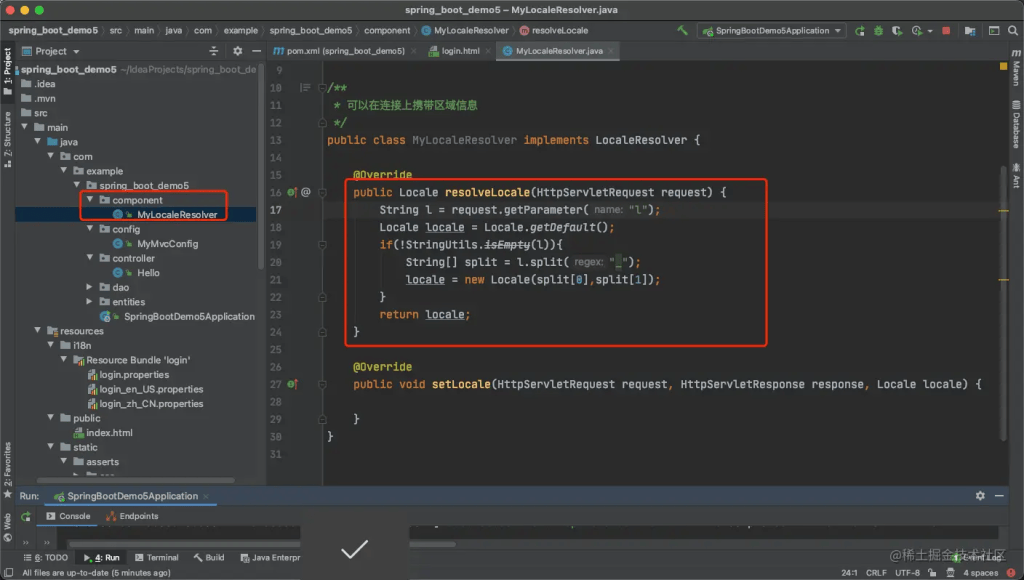 自己实现一个LocaleResolver,然后在配置类中注册组件到容器
自己实现一个LocaleResolver,然后在配置类中注册组件到容器
@Bean
public LocaleResolver localeResolver(){
return new MyLocaleResolver();
}
实现效果:


3)登录
@Controller
public class Login {
// @RequestMapping(value = "/user/login", method = RequestMethod.POST)
@PostMapping(value = "/user/login")
public String login(@RequestParam("username") String username,
@RequestParam("password") String password,
Map<String, Object> map, HttpSession session) {
if (!StringUtils.isEmpty(username) && "1234".equals(password)) {
session.setAttribute("loginUser", username);
return "redirect:/main.html";
} else {
map.put("msg", "用户名密码错误");
return "login";
}
}
}
配置类中添加一个试图映射
registry.addViewController("/main.html").setViewName("dashboard");
错误消息显示:
<pstyle="color:red"th:text="${msg}"th:if="${not#strings.isEmpty(msg)}"></p>
4)拦截器进行登录检查
拦截器
// 登陆检查
public class LoginHandlerInterceptor implements HandlerInterceptor {
//目标方法执行之前
@Override
public boolean preHandle(HttpServletRequest request, HttpServletResponse response, Object handler) throws Exception {
Object user = request.getSession().getAttribute("loginUser");
if(user == null){
//未登陆,返回登陆页面
request.setAttribute("msg","没有权限请先登陆");
request.getRequestDispatcher("/index.html").forward(request,response);
return false;
}else{
//已登陆,放行请求
return true;
}
}
@Override
public void postHandle(HttpServletRequest request, HttpServletResponse response, Object handler, ModelAndView modelAndView) throws Exception {}
@Override
public void afterCompletion(HttpServletRequest request, HttpServletResponse response, Object handler, Exception ex) throws Exception {}
}
注册拦截器
// 所有的WebMvcConfigurerAdapter组件都会一起起作用
@Bean //将组件注册在容器
public WebMvcConfigurerAdapter webMvcConfigurerAdapter(){
WebMvcConfigurerAdapter adapter = new WebMvcConfigurerAdapter() {
@Override
public void addViewControllers(ViewControllerRegistry registry) {
registry.addViewController("/").setViewName("login");
registry.addViewController("/index.html").setViewName("login");
registry.addViewController("/main.html").setViewName("dashboard");
}
//注册拦截器
@Override
public void addInterceptors(InterceptorRegistry registry) {
//super.addInterceptors(registry);
// 静态资源; *.css , *.js
// SpringBoot已经做好了静态资源映射
registry.addInterceptor(new LoginHandlerInterceptor()).addPathPatterns("/**")
.excludePathPatterns("/index.html","/","/user/login");
}
};
return adapter;
}
5)员工列表
三种引入公共片段的th属性:
- th:insert:将公共片段整个插入到声明引入的元素中
- th:replace:将声明引入的元素替换为公共片段
- th:include:将被引入的片段的内容包含进这个标签中
<body>
<!--引入抽取的topbar-->
<!--模板名:会使用thymeleaf的前后缀配置规则进行解析-->
<div th:replace="commons/bar::topbar"></div>
<div class="container-fluid">
<div class="row">
<!--引入侧边栏-->
<div th:replace="commons/bar::#sidebar(activeUri='emps')"></div>
<main role="main" class="col-md-9 ml-sm-auto col-lg-10 pt-3 px-4">
<h2><a class="btn btn-sm btn-success" href="emp" th:href="@{/emp}">员工添加</a></h2>
<div class="table-responsive">
<table class="table table-striped table-sm">
<thead>
<tr>
<th>#</th>
<th>lastName</th>
<th>email</th>
<th>gender</th>
<th>department</th>
<th>birth</th>
<th>操作</th>
</tr>
</thead>
<tbody>
<tr th:each="emp:${emps}">
<td th:text="${emp.id}"></td>
<td>[[${emp.lastName}]]</td>
<td th:text="${emp.email}"></td>
<td th:text="${emp.gender}==0?'女':'男'"></td>
<td th:text="${emp.department.departmentName}"></td>
<td th:text="${#dates.format(emp.birth, 'yyyy-MM-dd HH:mm')}"></td>
<td>
<a class="btn btn-sm btn-primary" th:href="@{/emp/}+${emp.id}">编辑</a>
<button th:attr="del_uri=@{/emp/}+${emp.id}" class="btn btn-sm btn-danger deleteBtn">删除</button>
</td>
</tr>
</tbody>
</table>
</div>
</main>
<form id="deleteEmpForm" method="post">
<input type="hidden" name="_method" value="delete"/>
</form>
</div>
</div>
<!-- Bootstrap core JavaScript
================================================== -->
<!-- Placed at the end of the document so the pages load faster -->
<script type="text/javascript" src="asserts/js/jquery-3.2.1.slim.min.js" th:src="@{/webjars/jquery/3.3.1/jquery.js}"></script>
<script type="text/javascript" src="asserts/js/popper.min.js" th:src="@{/webjars/popper.js/1.11.1/dist/popper.js}"></script>
<script type="text/javascript" src="asserts/js/bootstrap.min.js" th:src="@{/webjars/bootstrap/4.0.0/js/bootstrap.js}"></script>
<!-- Icons -->
<script type="text/javascript" src="asserts/js/feather.min.js" th:src="@{/asserts/js/feather.min.js}"></script>
<script>
feather.replace()
</script>
<script>
$(".deleteBtn").click(function(){
//删除当前员工的
$("#deleteEmpForm").attr("action",$(this).attr("del_uri")).submit();
return false;
});
</script>
</body>
6)员工添加
请求添加页面
//来到员工添加页面
@GetMapping("/emp")
public String toAddPage(Model model){
//来到添加页面,查出所有的部门,在页面显示
Collection<Department> departments = departmentDao.getDepartments();
model.addAttribute("depts",departments);
return "emp/add";
}
添加页面的表单(见下方修改)
员工添加功能
//员工添加
//SpringMVC自动将请求参数和入参对象的属性进行一一绑定;要求请求参数的名字和javaBean入参的对象里面的属性名是一样的
@PostMapping("/emp")
public String addEmp(Employee employee){
//来到员工列表页面
System.out.println("保存的员工信息:"+employee);
//保存员工
employeeDao.save(employee);
// redirect: 表示重定向到一个地址 /代表当前项目路径
// forward: 表示转发到一个地址
return "redirect:/emps";
}
7)员工修改
查询员工信息并回显
//来到修改页面,查出当前员工,在页面回显
@GetMapping("/emp/{id}")
public String toEditPage(@PathVariable("id") Integer id,Model model){
Employee employee = employeeDao.get(id);
model.addAttribute("emp",employee);
//页面要显示所有的部门列表
Collection<Department> departments = departmentDao.getDepartments();
model.addAttribute("depts",departments);
//回到修改页面(add是一个修改添加二合一的页面);
return "emp/add";
}
修改和添加是同一个页面:
<!--需要区分是员工修改还是添加;-->
<form th:action="@{/emp}" method="post">
<!--发送put请求修改员工数据-->
<!--
1、SpringMVC中配置HiddenHttpMethodFilter;(SpringBoot自动配置好的)
2、页面创建一个post表单
3、创建一个input项,name="_method";值就是我们指定的请求方式
-->
<input type="hidden" name="_method" value="put" th:if="${emp!=null}"/>
<input type="hidden" name="id" th:if="${emp!=null}" th:value="${emp.id}">
<div class="form-group">
<label>LastName</label>
<input name="lastName" type="text" class="form-control" placeholder="zhangsan" th:value="${emp!=null}?${emp.lastName}">
</div>
<div class="form-group">
<label>Email</label>
<input name="email" type="email" class="form-control" placeholder="zhangsan@atguigu.com" th:value="${emp!=null}?${emp.email}">
</div>
<div class="form-group">
<label>Gender</label><br/>
<div class="form-check form-check-inline">
<input class="form-check-input" type="radio" name="gender" value="1" th:checked="${emp!=null}?${emp.gender==1}">
<label class="form-check-label">男</label>
</div>
<div class="form-check form-check-inline">
<input class="form-check-input" type="radio" name="gender" value="0" th:checked="${emp!=null}?${emp.gender==0}">
<label class="form-check-label">女</label>
</div>
</div>
<div class="form-group">
<label>department</label>
<!--提交的是部门的id-->
<select class="form-control" name="department.id">
<option th:selected="${emp!=null}?${dept.id == emp.department.id}" th:value="${dept.id}" th:each="dept:${depts}" th:text="${dept.departmentName}">1</option>
</select>
</div>
<div class="form-group">
<label>Birth</label>
<input name="birth" type="text" class="form-control" placeholder="zhangsan" th:value="${emp!=null}?${#dates.format(emp.birth, 'yyyy-MM-dd HH:mm')}">
</div>
<button type="submit" class="btn btn-primary" th:text="${emp!=null}?'修改':'添加'">添加</button>
</form>
修改功能
//员工修改;需要提交员工id;
@PutMapping("/emp")
public String updateEmployee(Employee employee){
System.out.println("修改的员工数据:"+employee);
employeeDao.save(employee);
return "redirect:/emps";
}
8)员工删除
<button th:attr="del_uri=@{/emp/}+${emp.id}" class="btn btn-sm btn-danger deleteBtn">删除</button>
<script>
$(".deleteBtn").click(function(){ //删除当前员工。先修改action地址再提交
$("#deleteEmpForm").attr("action",$(this).attr("del_uri")).submit();
return false;
});
</script>
删除功能方法:
//员工删除
@DeleteMapping("/emp/{id}")
public String deleteEmployee(@PathVariable("id") Integer id){
employeeDao.delete(id);
return "redirect:/emps";
}
错误处理机制
默认处理
浏览器返回一个默认的错误页面
Whitelabel Error Page
This application has no explicit mapping for /error, so you are seeing this as a fallback.
Sun Jun 11 10:32:29 CST 2023
There was an unexpected error (type=Not Found, status=404).
客户端请求默认返回JSON数据提示错误
{
"timestamp": "2023-06-11T02:37:03.631+00:00",
"status": 404,
"error": "Not Found",
"path": "/hello1"
}
一但系统出现4xx或者5xx之类的错误,ErrorPageCustomizer就会生效(定制错误的响应规则),就会来到/error请求,就会被BasicErrorController处理
@Value("${error.path:/error}")
private String path = "/error";
// 系统出现错误以后来到error请求进行处理;(web.xml注册的错误页面规则)
private ModelAndView resolve(String viewName, Map<String, Object> model) {
//默认SpringBoot可以去找到一个页面? error/404
String errorViewName = "error/" + viewName;
//模板引擎可以解析这个页面地址就用模板引擎解析
TemplateAvailabilityProvider provider = this.templateAvailabilityProviders
.getProvider(errorViewName, this.applicationContext);
if (provider != null) {
//模板引擎可用的情况下返回到errorViewName指定的视图地址
return new ModelAndView(errorViewName, model);
}
//模板引擎不可用,就在静态资源文件夹下找errorViewName对应的页面 error/404.html
return resolveResource(errorViewName, model);
}
定制错误页面
1)有模板引擎的情况下:error/状态码。将错误页面命名为 错误状态码.html 放在模板引擎文件夹里面的error文件夹下,发生此状态码的错误就会来到对应的页面;
我们可以使用 4xx 和 5xx 作为错误页面的文件名来匹配这种类型的所有错误。精确优先(优先寻找精确的状态码.html)
页面能获取的信息:timestamp:时间戳、status:状态码、error:错误提示、exception:异常对象、message:异常消息、errors:JSR303数据校验的错误都在这里
2)没有模板引擎(模板引擎找不到这个错误页面),静态资源文件夹下找;
3)以上都没有错误页面,就是默认来到SpringBoot默认的错误提示页面;

定制错误JSON数据
1、方式1:自定义异常处理&返回定制json数据
@ControllerAdvice
public class MyExceptionHandler {
@ResponseBody
@ExceptionHandler({UserNotExistException.class})
public Map<String, Object> handleException(Exception e) {
Map<String, Object> map = new HashMap<>();
map.put("code", "user.notexist");
map.put("message", e.getMessage());
return map;
}
}
缺点:没有自适应效果(浏览器和客户端请求返回的都是JSON数据)
2、转发到/error进行自适应响应效果处理
@ControllerAdvice
public class MyExceptionHandler {
@ExceptionHandler({UserNotExistException.class})
public String handleException(Exception e, HttpServletRequest request) {
Map<String, Object> map = new HashMap<>();
request.setAttribute("javax.servlet.error.status_code", 500);
map.put("code", "user.notexist");
map.put("message", e.getMessage());
// 转发到 /error
return "forward:/error";
}
}
配置嵌入式Servlet容器
SpringBoot默认使用Tomcat作为嵌入式的Servlet容器
定制修改Servlet容器的相关配置
方式1:修改和server有关的配置(ServerProperties【本质也是EmbeddedServletContainerCustomizer】)
server.port=8081
server.context‐path=/crud
server.tomcat.uri‐encoding=UTF‐8
//通用的Servlet容器设置
server.xxx
//Tomcat的设置
server.tomcat.xxx
方式2:编写一个EmbeddedServletContainerCustomizer:嵌入式的Servlet容器的定制器,来修改Servlet容器的配置
@Bean //一定要将这个定制器加入到容器中
publicEmbeddedServletContainerCustomizerembeddedServletContainerCustomizer(){
return new EmbeddedServletContainerCustomizer() {
//定制嵌入式的Servlet容器相关的规则
@Override
public void customize(ConfigurableEmbeddedServletContainer container) {
container.setPort(8083);
}
};
}
注册Servlet三大组件
由于SpringBoot默认是以jar包的方式启动嵌入式的Servlet容器来启动SpringBoot的web应用,没有web.xml文件。 注册三大组件(Servlet、Filter、Listener)用以下方式:
ServletRegistrationBean
@Configuration
public class MyServerConfig {
// 注册三大组件
@Bean
public ServletRegistrationBean myServlet(){
ServletRegistrationBean registrationBean = new ServletRegistrationBean(new MyServlet(), "/myServlet");
return registrationBean;
}
}
// 请求 http://localhost:8080/myServlet 就会出现MyServlet中返回的内容
FilterRegistrationBean
@Bean
public FilterRegistrationBean myFilter(){
FilterRegistrationBean registrationBean = new FilterRegistrationBean();
registrationBean.setFilter(new MyFilter());
registrationBean.setUrlPatterns(Arrays.asList("/hello", "/myServlet"));
return registrationBean;
}
// 请求 http://localhost:8080/myServlet 就会出现MyFilter的doFilter()中输出的内容
ServletListenerRegistrationBean
@Bean
public ServletListenerRegistrationBean myListener(){
ServletListenerRegistrationBean<MyListener> registrationBean = new ServletListenerRegistrationBean<>(new MyListener());
return registrationBean;
}
// 输出结果:
contextInitialized---web应用启动
contextDestroyed---web应用关闭 // 这里是在点击暂停的时候
其他嵌入式Servlet容器
Tomcat(默认使用)
<dependency>
<groupId>org.springframework.boot</groupId>
<artifactId>spring‐boot‐starter‐web</artifactId>
// 引入web模块默认就是使用嵌入式的Tomcat作为Servlet容器;
</dependency>
Jetty(开发长连接应用)
<dependency>
<artifactId>spring‐boot‐starter‐jetty</artifactId>
<groupId>org.springframework.boot</groupId>
</dependency>
Undertow(不支持JSP)
<dependency>
<artifactId>spring‐boot‐starter‐undertow</artifactId>
<groupId>org.springframework.boot</groupId>
</dependency>
Spring Boot与Docker
Docker简介
Docker是一个开源的应用容器引擎,是一个轻量级容器技术。Docker支持将软件编译成一个镜像,然后在镜像中各种软件做好配置,将镜像发布出去,其他使用者可以直接使用这个镜像;运行中的这个镜像称为容器,容器启动是非常快速的。
- **docker镜像(Images)**:Docker镜像是用于创建Docker容器的模板
- **docker容器(Container)**:容器是独立运行的一个或一组应用
- **docker客户端(Client)**:客户端通过命令行或者其他工具使用Docker API(docs.docker.com/reference/a…) 与 Docker 的守护进程通信,即:连接docker主机进行操作
- **docker主机(Host)**:一个物理或者虚拟的机器用于执行Docker守护进程和容器。即:安装了Docker程序的机器(Docker直接安装在操作系统之上)
- **docker仓库(Registry)**:Docker仓库用来保存镜像,可以理解为代码控制中的代码仓库。Docker Hub(hub.docker.com) 提供了庞大的镜像集合供使用。
使用Docker的步骤:
1)安装Docker
2)去Docker仓库找到这个软件对应的镜像
3)使用Docker运行这个镜像,这个镜像就会生成一个Docker容器
4)对容器的启动停止就是对软件的启动停止
安装Docker
安装教程可参考:www.runoob.com/docker/maco…
$ docker info
Docker常用操作
镜像操作
| 操作 | 命令 | 说明 |
|---|---|---|
| 检索 | docker search 关键字 | |
| eg:docker search redis | 我们经常去docker hub上检索镜像的详细信息,如镜像的TAG | |
| 拉取 | docker pull 镜像名:tag | :tag是可选的,tag表示标签,多为软件的版本,默认是latest |
| 列表 | docker images | 查看所有本地镜像 |
| 删除 | docker rmi image-id | 删除指定的本地镜像 |
容器操作
流程:软件镜像(QQ安装程序)–>运行镜像–>产生一个容器(正在运行的软件,运行的QQ)
| 操作 | 命令 | 说明 |
|---|---|---|
| 运行 | docker run –name container-name -d image-name | |
| eg:docker run –name myredis –d redis | -name:自定义容器名 | |
| -d:后台运行 | ||
| image-name:指定镜像模板 | ||
| 列表 | docker ps(查看运行中的容器) | 加上-a可以查看所有容器 |
| 停止 | docker stop container-name/container-id | 停止当前运行的容器 |
| 启动 | docker start container-name/container-id | 启动容器 |
| 删除 | docker rm container-id | 删除指定容器 |
| 端口映射 | -p 6379:6379 | |
| eg:docker run -d -p 6379:6379 –name myredis docker.io/redis | -p: 主机端口(映射到)容器内部的端口 | |
| ‐d:后台运行 | ||
| 容器日志 | docker logs container-name/container-id |
更多命令可查看:docs.docker.com/engine/refe…
示例(tomcat):
% docker images //查看镜像列表
% docker search tomcat //搜索镜像
% docker pull tomcat //拉取镜像
% docker run --name myTomcat -d tomcat:latest //根据镜像启动容器
% docker ps //查看运行中的容器
------输出------
CONTAINER ID IMAGE COMMAND CREATED STATUS PORTS NAMES
700a4fa11db6 tomcat:latest "catalina.sh run" 25 seconds ago Up 24 seconds 8080/tcp myTomcat
% docker stop 700a4fa11db6[容器ID] //停止运行中的容器
% docker ps -a //查看所有的容器
------输出------
CONTAINER ID IMAGE COMMAND CREATED STATUS PORTS NAMES
700a4fa11db6 tomcat:latest "catalina.sh run" 5 minutes ago Exited (143) About a minute ago myTomcat
% docker start 700a4fa11db6[容器ID] //启动容器
% docker rm 700a4fa11db6[容器ID] //删除一个容器
% docker run -d -p 8888:8080 tomcat //启动一个做了端口映射的tomcat
‐d:后台运行
‐p: 将主机的端口映射到容器的一个端口 主机端口:容器内部的端口
------docker ps 输出------
CONTAINER ID IMAGE COMMAND CREATED STATUS PORTS NAMES
8dbc9df132b4 tomcat "catalina.sh run" 19 seconds ago Up 19 seconds 0.0.0.0:8888->8080/tcp eloquent_moore
% dockerlogscontainer‐name/container‐id //查看容器的日志
示例(mysql):
% docker pull mysql
% docker run --name mysql01 -e MYSQL_ROOT_PASSWORD=123456 -d mysql //启动mysql
------输出------
c9c10a720ba86f440737503396019c80ad0de88b8ae659e19214d8eda3253481
几个其他的高级操作:
docker run --name mysql03 ‐v /conf/mysql:/etc/mysql/conf.d ‐e MYSQL_ROOT_PASSWORD=my-secret-pw -d mysql:tag
把主机的/conf/mysql文件夹挂载到mysql docker容器的/etc/mysql/conf.d文件夹里面
改mysql的配置文件就只需要把mysql配置文件放在自定义的文件夹下(/conf/mysql)
docker run --name some‐mysql ‐e MYSQL_ROOT_PASSWORD=my-secret-pw -d mysql:tag --character‐set‐server=utf8mb4 ‐‐collation‐server=utf8mb4 --collation -server=utf8mb4_unicode_ci
指定mysql的一些配置参数
Spring Boot与数据访问
对于数据访问层,无论是SQL还是NOSQL,Spring Boot默认采用整合Spring Data的方式进行统一处理,添加大量自动配置,屏蔽了很多设置。引入各种xxxTemplate、xxxRepository来简化我们对数据访问层的操作。对我们来说只需要进行简单的设置即可。
JDBC、MyBatis、JPA
整合JDBC 🔥
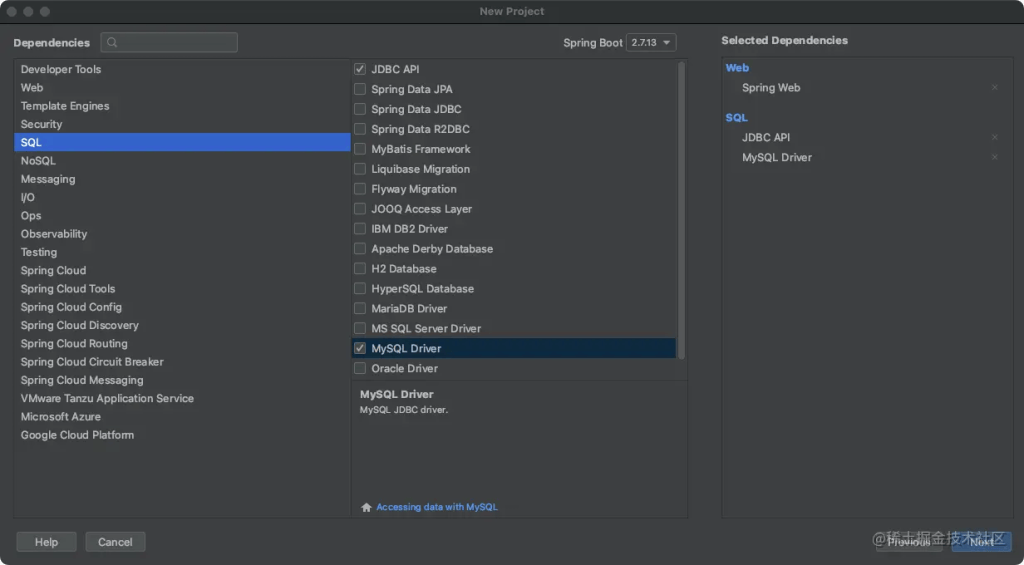
配置:
spring.datasource.url=jdbc:mysql://127.0.0.1:3306/jdbc
spring.datasource.username=root
spring.datasource.password=root
spring.datasource.driver-class-name=com.mysql.jdbc.Driver
测试代码:
@SpringBootTest
class SpringDemo08JdbcApplicationTests {
@Autowired
DataSource dataSource;
@Test
void contextLoads() {
// 默认使用的是 class com.zaxxer.hikari.HikariDataSource 数据源
System.out.println(dataSource.getClass());
}
}
数据源的相关配置都在DataSourceProperties源代码里面
// 源码
@ConfigurationProperties(
prefix = "spring.datasource"
)
SpringBoot默认可以支持:org.apache.tomcat.jdbc.pool.DataSource、HikariDataSource、BasicDataSource、自定义数据源类型。
验证JDBC
配置文件里增加如下配置:
#spring.datasource.initialization-mode=always 此行已失效,使用下面的
spring.sql.init.mode=always
编写SQL并放在resources文件夹下面

启动springboot工程,刷新数据库,可以看到表成功创建(下次启动还是会创建,所以最好创建完毕后删除sql文件)

编写测试查询代码
@SpringBootTest
class SpringDemo08JdbcApplicationTests {
@Autowired
JdbcTemplate jdbcTemplate;
@Test
void contextLoads() {
List<Map<String, Object>> list = jdbcTemplate.queryForList("select * from Skynet_test");
System.out.println(list);
// [{id=46, date=2023-06-01, APPversion=1.2.3, uv=123456, tag=gray, platform=Android,
// create_time=2023-06-01, last_modify=2023-06-01, version=1.2}]
}
}
整合Druid数据源
引入依赖
<!--引入自定义数据源druid-->
<dependency>
<groupId>com.alibaba</groupId>
<artifactId>druid</artifactId>
<version>1.1.8</version>
</dependency>
修改配置文件
spring.datasource.url=jdbc:mysql://127.0.0.1:3306/jdbc
spring.datasource.username=root
spring.datasource.password=root1234
spring.datasource.driver-class-name=com.mysql.cj.jdbc.Driver
spring.datasource.type=com.alibaba.druid.pool.DruidDataSource // 切换数据源
测试代码
@Test
void contextLoads() {
System.out.println(dataSource.getClass()); // class com.alibaba.druid.pool.DruidDataSource
}
配置生效:
@Configuration
public class DruidConfig {
@ConfigurationProperties(prefix = "spring.datasource")
@Bean
public DataSource druid(){
return new DruidDataSource();
}
// 这样在配置文件中配置druid的一些属性就可以生效了
}
整合Mybatis 🔥
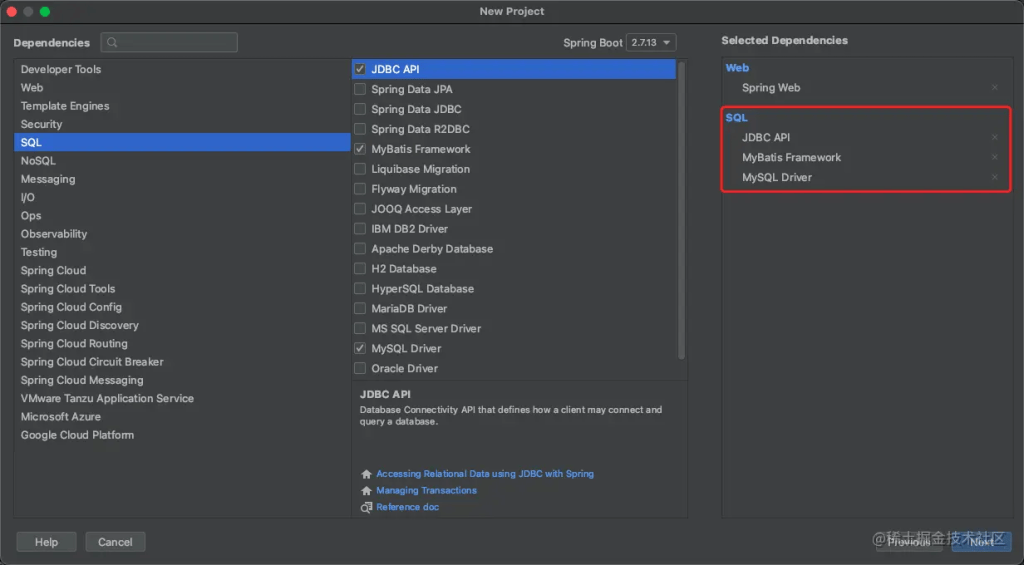
验证Mybatis
引入上方的druid数据源
配置文件:
spring.datasource.url=jdbc:mysql://127.0.0.1:3306/jdbc
spring.datasource.username=root
spring.datasource.password=root1234
spring.datasource.driver-class-name=com.mysql.cj.jdbc.Driver
spring.datasource.type=com.alibaba.druid.pool.DruidDataSource
建表语句:
CREATE TABLE `department` (
`id` int NOT NULL AUTO_INCREMENT,
`departmentName` varchar(255) DEFAULT NULL,
PRIMARY KEY (`id`)
) ENGINE=InnoDB DEFAULT CHARSET=utf8mb3;
CREATE TABLE `employee` (
`id` int NOT NULL AUTO_INCREMENT,
`lastName` varchar(255) DEFAULT NULL,
`email` varchar(255) DEFAULT NULL,
`gender` int DEFAULT NULL,
`d_id` int DEFAULT NULL,
PRIMARY KEY (`id`)
) ENGINE=InnoDB DEFAULT CHARSET=utf8mb3;
创建JavaBean:Employee & Department
注解版
@Mapper //指定这是一个操作数据库的mapper
public interface DepartmentMapper {
@Select("select * from department where id=#{id}")
public Department getDeptById(Integer id);
@Delete("delete from department where id=#{id}")
public int deleteDeptById(Integer id);
@Options(useGeneratedKeys = true, keyProperty = "id")
@Insert("insert into department(departmentName) values (#{departmentName})")
public int insertDept(Department department);
@Update("update department set departmentName=#{departmentName} where id=#{id}")
public int updateDept(Department department);
}
测试验证:
@RestController
public class DepartmentController {
@Autowired
DepartmentMapper departmentMapper;
@GetMapping("/dept/{id}")
public Department getDepartment(@PathVariable("id") Integer id) {
return departmentMapper.getDeptById(id);
// 测试链接:http://localhost:8080/dept/1
// 返回:{"id":1,"departmentName":"开发部"}
}
@GetMapping("/dept")
public Department insertDepartment(Department department) {
departmentMapper.insertDept(department);
return department;
// 测试链接:http://localhost:8080/dept?departmentName=开发部
// 返回:{"id":1,"departmentName":"开发部"}
}
}
如果此时数据库里字段是(department_name),查询结果就展示不出来名字了:{“id”:1,”departmentName”:null}。如何开启驼峰命名法配置?方法是自定义MyBatis的配置规则,给容器中添加一个ConfigurationCustomizer:
@org.springframework.context.annotation.Configuration
public class MyBatisConfig {
@Bean
public ConfigurationCustomizer configurationCustomizer(){
return new ConfigurationCustomizer() {
@Override
public void customize(Configuration configuration) {
configuration.setMapUnderscoreToCamelCase(true); // 开启驼峰命名
}
};
}
}
另一个问题是,每个mapper上都需要标注@Mapper注解,自动扫描配置呢?
@MapperScan(value = "com.example.spring_demo09_mybatis.mapper") // 批量扫描所有的Mapper接口
@SpringBootApplication
public class SpringDemo09MybatisApplication {
public static void main(String[] args) {
SpringApplication.run(SpringDemo09MybatisApplication.class, args);
}
}
配置文件版
@Mapper
public interface EmployeeMapper {
public Employee getEmpById(Integer id);
public void insertEmp(Employee employee);
}
mybatis配置文件:
<?xml version="1.0" encoding="UTF-8" ?>
<!DOCTYPE configuration
PUBLIC "-//mybatis.org//DTD Config 3.0//EN"
"http://mybatis.org/dtd/mybatis-3-config.dtd">
<configuration>
<settings>
<setting name="mapUnderscoreToCamelCase" value="true"/>
</settings>
</configuration>
<?xml version="1.0" encoding="UTF-8" ?>
<!DOCTYPE mapper
PUBLIC "-//mybatis.org//DTD Mapper 3.0//EN"
"http://mybatis.org/dtd/mybatis-3-mapper.dtd">
<mapper namespace="com.example.spring_demo09_mybatis.mapper.EmployeeMapper">
<!-- public Employee getEmpById(Integer id);-->
<select id="getEmpById" resultType="com.example.spring_demo09_mybatis.bean.Employee">
SELECT * FROM employee WHERE id=#{id}
</select>
<!--public void insertEmp(Employee employee);-->
<insert id="insertEmp">
INSERT INTO employee(lastName,email,gender,d_id) VALUES (#{lastName},#{email},#{gender},#{dId})
</insert>
</mapper>
修改Spring配置文件增加如下内容:
#mybatis
#指定全局配置文件的位置
mybatis.config-location=classpath:mybatis/mybatis-config.xml
#指定sql映射文件的位置
mybatis.mapper-locations=classpath:mybatis/mapper/*.xml
测试方法:
@GetMapping("/emp/{id}")
public Employee getEmp(@PathVariable("id") Integer id) {
return employeeMapper.getEmpById(id);
// 测试链接:http://localhost:8080/emp/1
// 返回:{"id":1,"lastName":"Wang","gender":1,"email":"1111@qq.com","dId":1}
}
整合JPA
Spring Data 项目的目的是为了简化构建基于 Spring 框架应用的数据访问技术,包括非关系数据库、 Map-Reduce 框架、云数据服务等等,另外也包含对关系数据库的访问支持。
SpringData 为我们提供使用统一的API来对数据访问层进行操作,这主要是Spring Data Commons项目来实现的。Spring Data Commons让我们在使用关系型或者非关系型数据访问技术时都基于Spring提供的统一标准,标准包含了CRUD(创建、获取、更新、删除)、查询、 排序和分页的相关操作。
统一的Repository接口:
- Repository<T, ID extends Serializable>:统一接口
- RevisionRepository<T, ID extends Serializable, N extends Number & Comparable>:基于乐观锁机制
- CrudRepository<T, ID extends Serializable>:基本CRUD操作
- PagingAndSortingRepository<T, ID extends Serializable>:基本CRUD及分页
提供数据访问模板类 xxxTemplate,如:MongoTemplate、RedisTemplate等
验证JPA
1)、编写一个bean实体类和数据表进行映射,并且配置好映射关系;
package com.example.spring_demo10_jpa.entity;
import javax.persistence.*;
// 使用JPA注解配置映射关系
@Entity //告诉JPA这是一个实体类(和数据表映射的类)
@Table(name = "tbl_user") // @Table来指定和哪个数据表对应,如果省略默认表名就是user
public class User {
@Id // 代表这是一个主键
@GeneratedValue(strategy = GenerationType.IDENTITY) // 自增主键
private Integer id;
@Column(name = "name", length = 50) // 这是和数据表对应的一个列
private String name;
@Column // 省略默认列名就是属性名
private String email;
}
2)、编写一个Dao接口来操作实体类对应的数据表(Repository)
// 继承JpaRepository来完成对数据库的操作
public interface UserRepository extends JpaRepository<User, Integer> {
}
3)、基本的配置
#jpa
#更新或者创建数据表结构
spring.jpa.hibernate.ddl-auto=update
#控制台新鲜事SQL
spring.jpa.show-sql=true
4)、启动工程,自动生成数据表:
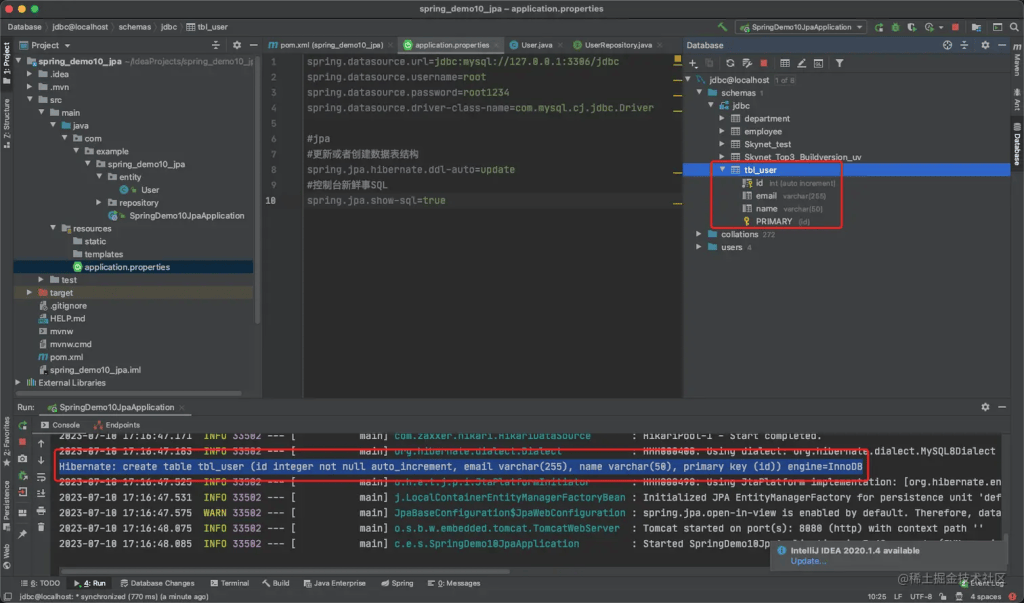
5)、测试
@RestController
public class UserController {
@Autowired
UserRepository userRepository;
// @GetMapping("/user/{id}")
// public User getUser(@PathVariable("id") Integer id){
// User user = userRepository.findOne(id);
// return user;
// }
@GetMapping("/user")
public User insertUser(User user){
User save = userRepository.save(user);
return save;
}
}
请求http://localhost:8080/user?name=haha&email=qqqq@qq.com会进行日志输出:
Hibernate: insert into tbl_user (email, name) values (?, ?)
Spring Boot启动配置原理
启动流程
SpringApplication.run(主程序类)
1、 创建SpringApplication对象;
这一步主要是加载并保存所有的 ApplicationContextInitializer 和 ApplicationListener,并获取到主程序类
2、运行run()方法;
回调所有的SpringApplicationRunListener的starting、准备环境、创建ioc容器对象(web环境容器和普通环境容器)
事件监听机制
1、准备环境
- 执行ApplicationContextInitializer. initialize()
- 监听器SpringApplicationRunListener回调contextPrepared
- 加载主配置类定义信息
- 监听器SpringApplicationRunListener回调contextLoaded
2、刷新启动IOC容器
- 扫描加载所有容器中的组件
- 包括从META-INF/spring.factories中获取的所有EnableAutoConfiguration组件
3、回调容器中所有的ApplicationRunner、CommandLineRunner的run方法
4、监听器SpringApplicationRunListener回调finished
Spring Boot自定义starters
编写自动配置:
@Configuration //指定这个类是一个配置类
@ConditionalOnXXX //在指定条件成立的情况下自动配置类生效
@AutoConfigureAfter //指定自动配置类的顺序
@Bean //给容器中添加组件
@ConfigurationPropertie结合相关xxxProperties类来绑定相关的配置
@EnableConfigurationProperties//让xxxProperties生效加入到容器中
自动配置类要能加载,将需要启动就加载的自动配置类,配置在META‐INF/spring.factories
org.springframework.boot.autoconfigure.EnableAutoConfiguration=\
org.springframework.boot.autoconfigure.admin.SpringApplicationAdminJmxAutoConfiguration,\
org.springframework.boot.autoconfigure.aop.AopAutoConfiguration,\
设计模式:
启动器starter只用来做依赖导入;专门写一个自动配置模块,启动器依赖这个自动配置模块;自定义启动器名-spring-boot-starter